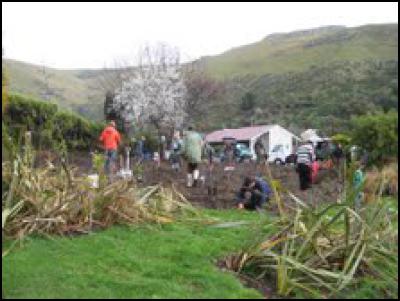Ground Breaking Planting in Christchurch
Ground Breaking Planting in Christchurch

What is quite possibly the first Food Forest in Christchurch was planted yesterday.
Spokesperson for the Sumner Community Garden organisation which is undertaking the project, Lucy Loughnan, says more than 50 different trees and berries were planted on Sunday morning in the grounds of the Van Asch School grounds, the culmination of many months of planning and hard work.
“We have had essential support and advice from a professional permaculturist who completed a site specific plan for our forest which was designed by a team of eight, and we have held several working bees involving up to 50 community members,” says Lucy Loughnan.
Hagley Ferrymead City Councillor Paul Lonsdale joined the organisation in the school grounds as the trees and plants went in.
“The weather wasn’t great yesterday but that didn’t stop this hardy bunch getting the job done. I am hugely supportive of the project and congratulate the community on leading this initiative,” he said.
The group also planted a number of different species around the base of the trees; a set of companion plants that work in harmony with each species, as well as supporting their growth and fruit production.
With minimal effort, apart from pruning and seasonal mulching, over time the food forest will look after itself, enabling the community to be able to wander through the forest and pick the fruit and berries as they ripen, says Lucy Loughnan.
“We have deliberately chosen plants that are suitable to our area, varieties that are not available in shops, and a selection of varieties that will fruit across the whole season so there will always be something to see in the food forest.”
Loughnan says the food forest is like a normal "native forest" with layers, or canopies, each with its own purpose, and also providing habitats for native wildlife.
“A food forest has seven layers, each providing different environments for different edible plant or trees. Using the concept of permaculture, each tree or plant has an additional purpose, as they are chosen to either supplement or provide nutrition, provide shelter, draw beneficial insects/wildlife, provide pollinators, detract unwanted insects, and so on,” she says.
From nuts at the very top; apple trees in the next level; citrus in sun, and shelter, stone fruit to ripen in the sun; feijoa that can tolerate wind; climbers that can climb up tall trees; bushes such as berries or currants, and lower levels of strawberries, herbs; soil conditioners like comfrey and the like - all are planned and planted using companion planting, so that in about seven years when the trees are reaching maturity, it is self-sustaining, with virtually little maintenance required. A bit of pruning in the winter, and just chop and drop of the plants that provide nutrition at the bases, as they will breakdown where they fall feeding the trees.
Lucy Loughnan says these tasks could easily be incorporated into educational opportunities.
“We have many schools and pre-schools who visit our garden on a regular basis and this will be a further educational opportunity for them.”
She adds that from the research undertaken by the Sumner Community Garden organisation, these projects will be of interest to many who will be visiting Christchurch and they are confident the fruit forest will be another attraction for Sumner.
ends


 Gordon Campbell: On The Clash Between Auckland Airport And Air New Zealand
Gordon Campbell: On The Clash Between Auckland Airport And Air New Zealand NZ Government: Reducing Ambiguity About What Is Reasonably Practicable For Health And Safety Compliance
NZ Government: Reducing Ambiguity About What Is Reasonably Practicable For Health And Safety Compliance Office of the Speaker: New Zealand Parliamentarians Attend 150th IPU Assembly
Office of the Speaker: New Zealand Parliamentarians Attend 150th IPU Assembly RNZRSA: RNZRSA Supports Willie Apiata VC's Stand To Drive Change To Veterans’ Support Act
RNZRSA: RNZRSA Supports Willie Apiata VC's Stand To Drive Change To Veterans’ Support Act Diane McCarthy - LDR: War Hero Willie Apiata Entrusts MP With Victoria Cross Medal
Diane McCarthy - LDR: War Hero Willie Apiata Entrusts MP With Victoria Cross Medal PSA: Disappointing Govt Attack On Diversity, Inclusion In Public Service
PSA: Disappointing Govt Attack On Diversity, Inclusion In Public Service NZ Labour Party: Govt Health And Safety Changes Put Workers At Risk
NZ Labour Party: Govt Health And Safety Changes Put Workers At Risk


